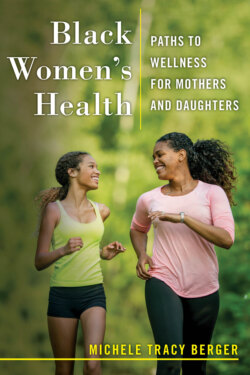Читать книгу Black Women's Health - Michele Tracy Berger - Страница 8
Why Mothers and Daughters
ОглавлениеThe dynamic nature of intergenerational learning about health by focusing on the mother-daughter relationship is one of the original contributions of this work. I use the sociological concept of “linked lives” as an organizing frame for exploring mother and daughter relationships.5 It is widely accepted that parent and child form a strong bond through social interaction, and that bond influences both parties throughout life.6 Mother-daughter relationships support growth and development as well as growth and change. The dyad of African American mothers and daughters is a central focus for several reasons. Like other girls, African American girls construct their female identity in relationship to their mothers.7 Similarly, African American mothers play a pivotal role in socializing their daughters into the complexities of young womanhood and identity development. Black mothering takes place within the sphere of inequality and that the socialization of daughters includes helping them navigate multiple and intersecting forms of oppression like race, class, and gender.8
For one, the health status for African American women and girls is marked by inequality in the areas of access, treatment, and resources; a focus on both through the dyad of mother-daughter relationships could yield important insights. There are other important demographic reasons why looking at mothers and daughters constitutes a useful focus. Demographically, Black mothers are more likely than other racial and ethnic minorities to head single-family households and also are more likely to head those families in the South.9 Although there are other family configurations in the African American community, this is a central one. There are also widely documented health risks associated with single parenting.10
If we look only at the national health data for African American women and girls, we miss much of the context that can help us understand the unique barriers they face in the pursuit of health. We may also miss or devalue how resiliency, advocacy, and social support may play a positive role in African American women’s and girls’ health experiences. Using a more intimate approach can help researchers make visible the daunting role that structural inequalities play in shaping people’s lives and provide insight into developing effective health interventions.
Black Women’s Health offers such an approach. Its focus is on southern African American mothers and their adolescent daughters, and it examines the themes that emerge about health, information about and access to health and health care, and sexuality in a crucial period of girls’ lives—early adolescence. It also pays particular attention to mothers’ framing of intimacy, relationships, and ideas about HIV risk. The South continues to be a region that exhibits overall lower health status of its residents than the rest of the nation. African Americans in the South have higher rates of HIV/AIDS, diabetes, heart disease, and other diseases.11 Moreover, the long-standing cultural taboos and silences about sexuality in the South continue to shape African American women’s and girls’ experiences.12
As one dimension of health, HIV/AIDS continues to be a vexing issue for policy makers and researchers alike. Rates of HIV infection among Black women in North Carolina reflect increasing rates of HIV infection in southern communities.13 Poverty plays a significant role in shaping African American women’s vulnerability to contract HIV.14 Researchers know little, however, about how Black women, particularly in the South, and from different economic backgrounds, understand and assess their risk of contracting HIV.15 We also know little about mother and daughter communication surrounding HIV. Thus, by delving into the daily experiences of African American mothers and daughters as they cope with, negotiate, and take action surrounding health, this book responds to many unanswered questions about mother-daughter communication regarding sexuality and HIV/AIDS awareness.
For example, we know that African American mothers employ sexual scripts in conversations with daughters, but we do not know enough about how these scripts affect their daughters’ behaviors.16 What do daughters find empowering or lacking in such scripts? How do these scripts prepare daughters for intimacy, and how do they raise awareness about various STDs? How can mother and daughter communication be strengthened to reduce HIV risk for both groups? My research provides the most comprehensive response to these questions to date, drawing from the population that faces the highest national health risk. From this data collected in North Carolina, Black Women’s Health provides findings that are particularly salient for understanding the challenges in the region, while expanding the findings to address larger patterns that place African American women at such high health risks nationally.
As I discuss below, Black Women’s Health fills an important void on health scholarship relating to African American girls and women. This is a timely discussion given the increasing focus on girlhood in women’s and gender studies and calls to focus on African American girls in response to government initiatives such as My Brother’s Keeper and the role of health in social movements, including Black Lives Matter and #SayHerName.17
No detailed book-length work privileges both components of the mother and daughter dyad and seeks to explore the bidirectional nature of learning and growth, specifically in the area of health.
